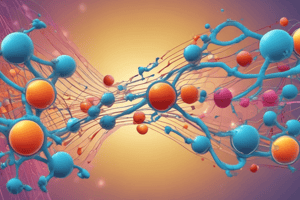Podcast
Questions and Answers
What is the primary function of catabolic reactions in our bodies?
What is the primary function of catabolic reactions in our bodies?
- Creating food molecules like glucose
- Storing energy in ATP
- Building complex molecules
- Releasing energy by breaking down chemical bonds (correct)
Which molecule temporarily stores the energy released from food molecules?
Which molecule temporarily stores the energy released from food molecules?
- Fats
- ATP (adenosine triphosphate) (correct)
- Enzymes
- Glucose
What process involves building processes and often requires energy from breaking down ATP?
What process involves building processes and often requires energy from breaking down ATP?
- Anabolic reactions (correct)
- Cellular respiration
- Metabolism
- Catabolic reactions
How many phosphates does ATP (adenosine triphosphate) have?
How many phosphates does ATP (adenosine triphosphate) have?
How do cells make ATP in the body?
How do cells make ATP in the body?
Catabolic reactions involve building up chemical bonds with enzymes.
Catabolic reactions involve building up chemical bonds with enzymes.
Metabolism includes anabolic reactions, which are breakdown types of reactions.
Metabolism includes anabolic reactions, which are breakdown types of reactions.
ATP (adenosine triphosphate) stores energy in its three phosphates.
ATP (adenosine triphosphate) stores energy in its three phosphates.
Anabolic reactions often require energy obtained from breaking down ATP.
Anabolic reactions often require energy obtained from breaking down ATP.
Cells make ATP through photosynthesis, a single-step process involving breakdown of food molecules like glucose.
Cells make ATP through photosynthesis, a single-step process involving breakdown of food molecules like glucose.
Cells make ATP through ______ respiration, a multi-step process involving oxidation and breakdown of food molecules like glucose.
Cells make ATP through ______ respiration, a multi-step process involving oxidation and breakdown of food molecules like glucose.
ATP has three ______ that, when broken, release a lot of energy, used to drive various processes in the body.
ATP has three ______ that, when broken, release a lot of energy, used to drive various processes in the body.
Anabolic reactions involve building processes and often require energy from breaking down ______.
Anabolic reactions involve building processes and often require energy from breaking down ______.
Energy released from food molecules is temporarily stored in ATP (adenosine triphosphate), a crucial energy ______.
Energy released from food molecules is temporarily stored in ATP (adenosine triphosphate), a crucial energy ______.
Metabolism includes catabolic reactions, which are ______ types of reactions.
Metabolism includes catabolic reactions, which are ______ types of reactions.
Match the following terms with their correct descriptions:
Match the following terms with their correct descriptions:
Match the following processes with their correct descriptions:
Match the following processes with their correct descriptions:
Match the following statements with the correct terms:
Match the following statements with the correct terms:
Match the following concepts with their correct definitions:
Match the following concepts with their correct definitions:
Match the following terms with their appropriate functions:
Match the following terms with their appropriate functions:
Study Notes
- Our bodies get energy from the potential energy stored in the chemical bonds of the food we eat, like sugars and fats.
- Catabolic reactions involve breaking down these chemical bonds with enzymes, releasing bits of energy.
- Metabolism includes catabolic reactions, which are breakdown types of reactions.
- Energy released from food molecules is temporarily stored in ATP (adenosine triphosphate), a crucial energy molecule.
- ATP has three phosphates that, when broken, release a lot of energy, used to drive various processes in the body.
- Anabolic reactions involve building processes and often require energy from breaking down ATP.
- Cells make ATP through cellular respiration, a multi-step process involving oxidation and breakdown of food molecules like glucose.
Studying That Suits You
Use AI to generate personalized quizzes and flashcards to suit your learning preferences.
Description
Test your knowledge on how our bodies derive energy from food through cellular respiration, ATP, catabolic, and anabolic reactions. Learn about the processes of breaking down and building up chemical bonds for energy storage and release.




